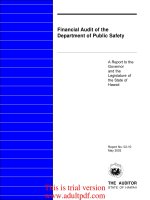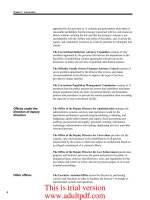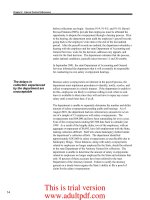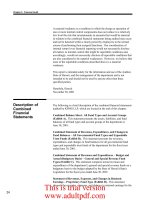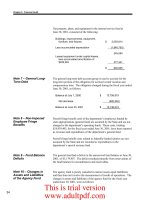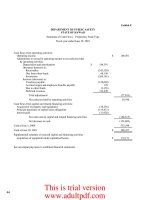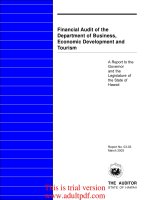Financial Audit of the Department of Public Safety A Report to the Governor and the Legislature _part6 pot
Bạn đang xem bản rút gọn của tài liệu. Xem và tải ngay bản đầy đủ của tài liệu tại đây (532.06 KB, 10 trang )
44
Chapter 3: Financial Audit
Exhibit E
Cash flows from operating activities:
Operating income $ 108,501
Adjustments to reconcile operating income to net cash provided
b
y operating activities:
Depreciation and amortization $ 184,391
(Increase) decrease in:
Receivables (243,328)
Due from other funds 68,150
Inventories (268,161)
Increase (decrease) in:
Vouchers payable (128,009)
Accrued wages and employee benefits payable 129
Due to other funds (3,376)
Deferred revenues 312,249
Total adjustments (77,955)
Net cash provided by operating activities 30,546
Cash flows from capital and related financing activities:
Acquisition of property and equipment (38,256)
Principal payments on capital lease obligations (114,431)
Interest paid (31,928)
Net cash used in capital and related financing activities (184,615)
Net decrease in cash (154,069)
Cash at July 1, 2000 552,546
Cash at June 30, 2001 $ 398,477
Supplemental schedule of noncash capital and financing activities –
acquisition of equipment under capitalized leases $ 172,171
See accompanying notes to combined financial statements.
Fiscal year ended June 30, 2001
DEPARTMENT OF PUBLIC SAFETY
STATE OF HAWAII
Statement of Cash Flows – Proprietary Fund Type
This is trial version
www.adultpdf.com
45
Notes
Notes
Chapter 2
1. The U.S. Bureau of Labor Statistics, "Current Population Survey
2000 Annual Averages."
This is trial version
www.adultpdf.com
4446
Chapter 1: Introduction
This page is intentionally left blank
This is trial version
www.adultpdf.com
47
Comments on
Agency Response
Response of the Affected Agency
We transmitted a draft of this report to the Department of Public Safety
(department) on April 25, 2002. A copy of the transmittal letter to the
department is included as Attachment 1. The response of the department
is included as Attachment 2.
The department responded that it appreciates that we recognized the
work that has been done in its specific problem areas; however, the
department believes that the report paints an incomplete and unfair
picture. Yet the department has accepted several of our
recommendations.
The department believes that our report oversimplifies the problems that
exist with overtime. The department reports that “all seven-day-per-
week, 24-hour-per-day operations will incur some level of overtime
because no matter what the circumstance, staff must provide a certain
level of coverage to maintain security and safety.” The department notes
that some facilities, especially the Women’s Community Correctional
Center and the Hawaii Community Correctional Center, have special
challenges such as gender-specific posts and inmate transportation
issues. While these examples may be relevant, overtime costs at 13
percent of total salary expense are still unacceptable and the department
must continue to work on improving the overtime incurred.
Concerning our finding regarding the alleged sick leave abuse at the
Waiawa Correctional Center and the Women’s Community Correctional
Center, the department’s response is misdirected. It was the
department’s own staff who stated that the alleged abuse was not
investigated because no clear evidence existed. But if an investigation is
not made into the allegations, how can the department make the
determination that “no clear evidence” exists? The allegations that sick
leave was used when employees were denied vacation leave and that
employees used sick leave time to care for their children during breaks
from school could have been easily researched. We stand by our
recommendation that any apparent abuse of sick leave should be
investigated in a timely manner.
The department has stated that it is unfair to compare ACOs’ levels of
sick leave usage with that of other state agencies and national averages.
We understand the department’s concerns with the comparison; however,
an average of 27 sick leave days taken during the fiscal year ended June
30, 2001 for all uniformed staff, which includes ACOs and medical and
food service staff, is extremely high. The average of 27 sick leave days
This is trial version
www.adultpdf.com
48
taken is more than twice the national average of 12 for all government
employees, as stated in our report. It is also higher than the 21 days of
sick leave days per year earned by employees hired before July 2001,
which the department has stated is a “very liberal leave policy.” Once
again, we stand by our finding that the continued unusual sick leave
patterns and the high levels of sick leave usage raise doubts about the
effectiveness of the department’s sick leave abuse program.
The department states that our report implies that “three ACOs had high
overtime despite poor attendance records.” This is an incorrect
statement. Our report does not make that implication. Our report
identifies two different samples used to test overtime and sick leave.
The overtime sample consisted of 21 ACOs, two food service staff, and
two medical staff. The sick leave sample consisted of 22 ACOs and
three food service staff. Also, for the three individuals with overtime
compensation greater than their base compensation, our report does not
identify whether they are ACOs, food service staff, or medical staff.
The department disagrees that “[t]he delays in collection experienced by
the department are unacceptable.” The department further discusses
what it has done to mitigate the salary overpayment problem. While we
commend the department for its efforts, the fact remains that as of June
30, 2001, $1.8 million in salary overpayments remained uncollected. We
understand the difficulties involved in the process, but consider $1.8
million a significant amount. The longer the balances remain
outstanding, the more difficult it becomes to collect on them.
This is trial version
www.adultpdf.com
ATTACHMENT 1
MARION M. HIGA
State Auditor
STATE OF HAWAII
OFFICE OF THE AUDITOR
465 S. King Street, Room 500
Honolulu, Hawaii 96813-2917
(808) 587-0800
FAX: (808) 587-0830
~
April 25, 2002
copy
The Honorable Ted Sakai
Director
Department of Public Safety
919 Ala Moana Boulevard
Honolulu, Hawaii 96814
Dear Mr. Sakai :
Enclosed for your information are three copies, numbered 6 to 8 of our confidential draft report,
Financial Audit of the Department of Public Safety. We ask that you telephone us by Friday,
April 26, 2002, on whether or not you intend to comment on our recommendations. If you wish
your comments to be included in the report, please submit them no later than Tuesday, April 30,
2002.
The Governor, and presiding officers of the two houses of the Legislature have also been
provided copies of this confidential draft report.
Since this report is not in final form and changes may be made to it, access to the report should
be restricted to those assisting you in preparing your response. Public release of the report will
be made solely by our office and only after the report is published in its final form.
Sincerely,
~~~
Marion M. Riga
State Auditor
Enclosures
49
This is trial version
www.adultpdf.com
A TT ACHMENT 2
TEDSAKAl
DIRECTOR
'ltl'It'IWJlf "' CII nT AJYO
UUVERNOR
PAULINE N. NAMUO
Deputy Director
Adminislrati on
MARIAN E. TSU.n
Deputy Director
Corrections
SmNEY A. HAYAKAWA
Deputy Director
Law Enforcement
STATE OF HAWAII
DEPARTMENT OF PUBLIC SAFETY
919Ala Moana Boulevard, 4th Floor
Honolulu, Hawaii 96814
RECE
~IED
HAr
iL 52 PH 'Ol
O f'.' Ct -r.,~ ~:I
D -
O D
r li .v' , , '- " " I I ~
STATE OF HAWAII
May l' 2002
Ms. Marion Higa
State Legislative Auditor
465 South King Street, Suite 500
Honolulu, Hawaii 96813
Dear Ms. Higa:
Thank you for the opportunity to respond to the draft of the Financial Audit
of the Department of Public Safety. The issues addressed in your report such as
overtime, overpayments, and the inmate trust accounting systems are highly
complex problems that have plagued the Department for many years. There are
no easy explanations or solutions to these problems. Our Department
appreciates any constructive input that your office has to offer .
I am pleased to report that the Department has made significant progress
towards financial accountability and your audit report affirms this. The
Department has significantly reduced both overtime expenditures and
overpayments. As your report points out, the overtime costs for our correctional
facilities decreased from $9.8 million in FY1999 to $7.6 million in FY2000. We're
pleased to report that in FY2001, overtime expenditures dropped again, to $7.37
million. In fact, the net decrease in overtime expenditures from FY1999 is even
more dramatic than implied by these statistics because during this period, the
base salaries for adult corrections officers increased by about 10%-20% a point
that the audit report did not mention.
In addition, your report states that the outstanding balance of salary
overpayments decreased from $2 million in June 2000 to $1.8 million in June
2001. When you consider that in June 1999, the overpayment balance was over
$2.3 million, the total reduction in overpayments is significant.
We are pleased that your report points out these improvements.
However, we must respond on some of the specific findings and conclusions
contained in the report, because they do not accurately reflect a full
understanding of the issues.
" An F.mJ,,! Onnnrhlnitv F.mnlnv 1 Ag"n=
50
This is trial version
www.adultpdf.com
Ms. Marion Higa
May 1 , 2002
Page 2
Overtime Driven by Sick Leave and Vacancies
Your report states that overtime is driven by sick leave and vacancies.
This is a gross oversimplification. Overtime in correctional facilities is a highly
complex matter that is driven by the interplay of a myriad of factors.
In 1999, we implemented new reporting systems designed to improve
accountability among our managers. One of our initial goals was to institute
controls on overtime spending. We identified more than 20 factors that cause
overtime, and sick leave is just one of them. These factors can be grouped in
two major categories. The first group includes factors that impact on the number
of employees available to work on any given shift. These include sick leave,
vacancies, vacation, workers' compensation, maternity leave, and military leave.
The second group involves the number of posts that must be filled over
and beyond the regular posts found on the established schedule. The special
duty posts are temporary and unforeseen. Often, they arise even after a shift
has started. For example, an inmate may be placed on suicide watch, which
requires one-on-one supervision by an Adult Correctional Officer (ACO). Or an
inmate may be hospitalized, requiring the presence of an ACO at the hospital.
Sometimes, there are an unexpected number of inmates who must be
transported out of the facility to go to court (we usually do not receive the court
calendar until the day before the appearance is required) or to an outside
doctor's appointment.
What your report fails to mention, or perhaps, what your staff doesn't know
is that all seven-day-per-week, 24-hour-per-day operations will incur some level
of overtime because no matter what the circumstance, staff must provide a
certain level of coverage to maintain security and safety. Therefore, a sufficient
shift-relief factor is also important in controlling overtime costs.
For some facilities, especially the Women's Community Correctional
Center (WCCC) and the Hawaii Community Correctional Center (HCCC),
controlling overtime presents a special challenge. WCCC historically has had
difficulty filling its high number of gender-specific posts. These are posts that can
be staffed only by femare officers. If a gender specific post is vacant because the
designated ACO is absent, then we must find another woman to fill the vacancy,
even if that woman will be on overtime, and even if there is a male ACO available
on regular time. On the Big Island, the HCCC transports inmates from Hilo to
courts in Kona, Waimea, and Puna and Ka'u, as well in HiJo. Because the Sheriff
Division is inadequately staffed to cover these courts, HCCC must provide
51
This is trial version
www.adultpdf.com
Ms. Marion Higa
May 1, 2002
Page 3
security for inmates who are in court. In other circuits, this duty is turned over to
the Sheriff Division. We found that court duty has accounted for about 20% of
HCCC's total overtime.
Staffing of Essential Posts
As in your previous report titled, Management and Financial Audit of the
Deoartment of Public Safety, you raise the issue of staffing of essential and
program posts. Work schedules for ACOs are prepared in accordance with
Section 61.04 of the Bargaining Unit 10 Agreement. The work schedule
language was negotiated with the United Public Workers and must be followed
by the Wardens. The Agreement requires that we identify essential posts, and
that we keep these posts filled at all times. On the other hand, the Agreement
does provide us with some flexibility with regard to program posts.
As your report notes, we ~ placed responsibility for control of overtime
costs with the Wardens and we've done so because the Wardens have proven
that they can fulfill this responsibility. Decisions about whether or not to fill a
vacant post, how that post will be filled, and whether overtime will be incurred to
fill the post is the responsibility of those directly in charge of post assignments for
each watch-the watch commander. Control of overtime, therefore, can only be
achieved at the facility level. It is the Wardens' responsibility to ensure that their
watch commanders are making appropriate decisions.
Patterns of Absence Due to Sickness Program
The audit report states that the Department's "existing sick leave abuse
program is ineffective against the misuse of sick leave." We strongly disagree.
The Department took a proactive approach to the problem of sick leave abuse,
and worked dosely with the United Public Workers to develop and implement the
only program in state government that deals with sick leave abuse. The program
has been successful in improving the attendance of those employees who have
been placed on the program. In fact, the program has been so successful that it
is now being implemented statewide, and our staff have been used as
consultants to other departments.
We continue to work with the unions to improve the program, but you must
understand that sick leave abuse is an extremely difficult allegation to
substantiate. As you know, we cannot require substantiation by a doctor unless
the employee is on sick leave for five or more consecutive days. On the other
hand, if an employee is on sick leave for less than five days, but brings in a
52
This is trial version
www.adultpdf.com
Ms. Marion Higa
May 1 , 2002
Page 4
doctor's note, we must accept it as substantiation. This is why some employees
who appear to have patterns of absence are not placed on the program. They
usually are able to substantiate their illness with a doctor's note, and we cannot
use that absence as part of the pattern.
The report states that we did not investigate several cases of suspected
sick leave abuse at Waiawa and WGGG. ApparentlyI the Auditors were told that
staff took sick leave because vacation was denied, and that staff took sick leave
to care for minor children. You further state that "no clear evidence exists" that
these reports were true. How do we know that "no clear evidence exists" if an
investigation did not take place? If there is "no clear evidence," then can we be
expected to take action?
The report further compares ACOs' levels of sick leave usage with that of
other state agencies and national averages. This is totally unfair. Corrections
present one of the most difficult working environments imaginable. ACOs
supervise criminals who are confined against their will. They must deal with this
population throughout their workday, in a very confined setting, while always
outnumbered. The stress inherent in the job is well documented. There are
three major problems with your comparison. First of all, comparing ACOs' sick
leave usage to departments who operate on a five-day workweek, with no
rotation or shift work, who observe all holidays is a naively unfair comparison. It
is akin to comparing apples to oranges. Secondly, the national averages that are
cited in your report do not define "protective services." It could include police
officers, but it could also include parking lot attendants. It also does not specify
whether such data came from public and/or private unionized or non-unionized
organizations. And finally, our State government as a whole, has a very liberal
leave policy, which allows for 21 days of sick leave per ye.ar for staff who were
hired before July 2001.
Overtime Compensation
The section of your report titled, "High sick leave usage results in
significant overtime costs to the department" raises several issues. First, we are
concerned that the sample that you selected to draw your conclusions about the
high level of overtime compensation for three Halawa staff members is biased.
Your staff obviously picked the worst cases, then generalized your conclusions to
include the entire department. That is, you pick out the worst cases, and then
conclude that out department's policies and procedures are inadequate because
of these worst cases.
53
This is trial version
www.adultpdf.com


